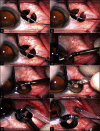Small gauge vitrectomy: Recent update
- PMID: 23772118
- PMCID: PMC3678194
- DOI: 10.4103/0974-620X.111893
Small gauge vitrectomy: Recent update
Abstract
Small gauge vitrectomy, also known as minimally invasive vitreous surgery (MIVS), is a classic example of progress in biomedical engineering. Disparity in conjunctival and scleral wound location and reduction in wound diameter are its core principles. Fluidic changes include increased pressure head loss with consequent reduction in infusional flow rate and use of higher aspiration vacuum at the cutter port. Increase An increase in port open/port closed time maintains an adequate rate of vitreous removal. High Intensity Discharge (HID) lamps maintain adequate illumination in spite of a decrease in the number of fiberoptic fibers. The advantages of MIVS are, a shorter surgical time, minimal conjunctival damage, and early postoperative recovery. Most complications are centered on wound stability and risk of postoperative hypotony, endophthalmitis, and port site retinal break formation. MIVS is suited in most cases, however, it can cause dehiscence of recent cataract wounds. Retraction of the infusion cannula in the suprachoroidal space may occur in eyes with scleral thinning. As a lot has been published and discussed about sutureless vitrectomy a review of this subject is necessary. A PubMed search was performed in December 2011 with terms small gauge vitrectomy, 23-gauge vitrectomy, 25-gauge vitrectomy, and 27 gauge vitrectomy, which were revised in August 2012. There were no restrictions on the date of publication but it was restricted to articles in English or other languages, if there abstracts were available in English.
Keywords: Pars plana vitrectomy; sutureless vitrectomy; vitreoretinal surgery.
Conflict of interest statement
Figures







Similar articles
-
A 27-gauge instrument system for transconjunctival sutureless microincision vitrectomy surgery.Ophthalmology. 2010 Jan;117(1):93-102.e2. doi: 10.1016/j.ophtha.2009.06.043. Epub 2009 Oct 31. Ophthalmology. 2010. PMID: 19880185
-
Sutureless vitrectomy.Indian J Ophthalmol. 2008 Nov-Dec;56(6):453-8. doi: 10.4103/0301-4738.43364. Indian J Ophthalmol. 2008. PMID: 18974514 Free PMC article. Review.
-
Complications associated with clear corneal cataract wounds during vitrectomy.Retina. 2010 Jun;30(6):850-5. doi: 10.1097/IAE.0b013e3181c70111. Retina. 2010. PMID: 20090563
-
Bacterial contamination of the vitreous cavity associated with transconjunctival 25-gauge microincision vitrectomy surgery.Ophthalmology. 2010 Apr;117(4):811-7.e1. doi: 10.1016/j.ophtha.2009.09.030. Epub 2010 Jan 25. Ophthalmology. 2010. PMID: 20097429 Clinical Trial.
-
[Dry transconjunctival sutureless 25-gauge vitrectomy in the treatment of pediatric cataract].Zhonghua Yan Ke Za Zhi. 2009 Aug;45(8):762-5. Zhonghua Yan Ke Za Zhi. 2009. PMID: 20021895 Review. Chinese.
Cited by
-
Factors regulating the gripping force and stiffness of 25- and 27-gauge internal limiting membrane forceps.PLoS One. 2024 Nov 5;19(11):e0310419. doi: 10.1371/journal.pone.0310419. eCollection 2024. PLoS One. 2024. PMID: 39499714 Free PMC article.
-
Pars plana vitrectomy in uveitis in the era of microincision vitreous surgery.Indian J Ophthalmol. 2020 Sep;68(9):1844-1851. doi: 10.4103/ijo.IJO_1625_20. Indian J Ophthalmol. 2020. PMID: 32823401 Free PMC article. Review.
-
Hybrid 23/27 Gauge Vitrectomy - Combining the Charm of 27G with the Efficacy of 23G.Clin Ophthalmol. 2020 Jan 31;14:299-305. doi: 10.2147/OPTH.S233884. eCollection 2020. Clin Ophthalmol. 2020. PMID: 32099314 Free PMC article.
-
Active Silicone Oil Removal with a Transconjunctival Sutureless System: Is the 23-Gauge System Safe and Effective?Turk J Ophthalmol. 2016 Jan;46(1):11-15. doi: 10.4274/tjo.15807. Epub 2016 Jan 5. Turk J Ophthalmol. 2016. PMID: 27800251 Free PMC article.
-
A Prospective Randomized Study Comparing 27-Gauge Vitrectomy to 23-Gauge Vitrectomy for Epiretinal Membranes and Full-Thickness Macular Holes.J Curr Ophthalmol. 2024 Mar 29;35(3):259-266. doi: 10.4103/joco.joco_318_22. eCollection 2023 Jul-Sep. J Curr Ophthalmol. 2024. PMID: 38681686 Free PMC article.
References
-
- Machemer R, Buettner H, Norton EW, Parel JM. Vitrectomy: A pars plana approach. Trans Am Acad Ophthalmol Otolaryngol. 1971;75:813–20. - PubMed
-
- Charles S, Calzada J, Wood B. Text Book of Vitreous Microsurgery. 2nd ed. London: Williams and Wilkins; 1999. p. 45.
-
- Klöti R. [Vitrectomy. I. A new instrument for posterior vitrectomy] Albrecht Von Graefes Arch Klin Exp Ophthalmol. 1973;187:161–70. - PubMed
-
- Chen JC. Sutureless pars plana vitrectomy through self-sealing sclerotomies. Arch Ophthalmol. 1996;114:1273–5. - PubMed
-
- Kwok AK, Tham CC, Lam DS, Li M, Chen JC. Modified sutureless sclerotomies in pars plana vitrectomy. Am J Ophthalmol. 1999;127:731–3. - PubMed
LinkOut - more resources
Full Text Sources
Other Literature Sources
Research Materials
Miscellaneous

